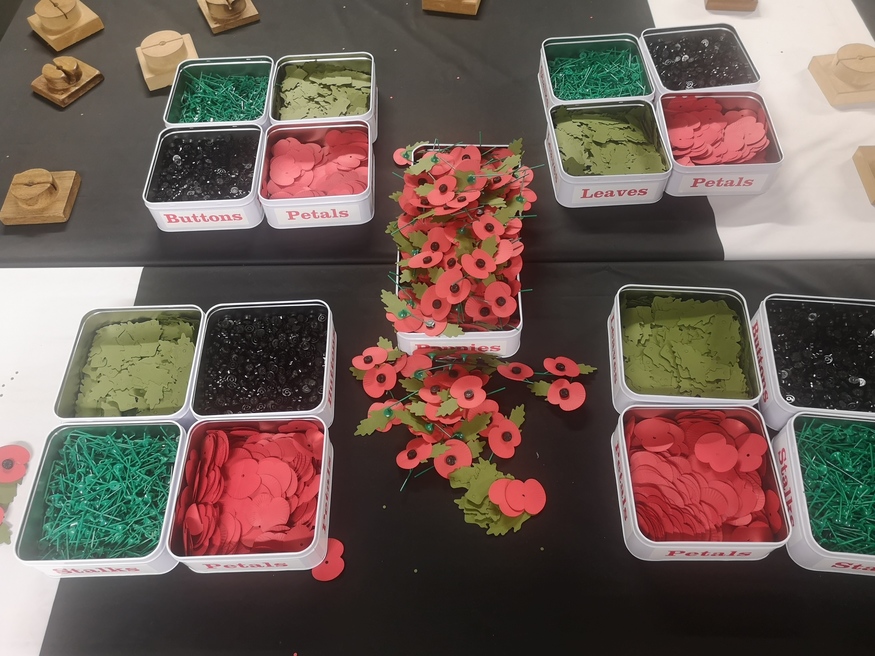
The Remembrance Poppy: that most British of symbols. Except it represents a Flemish corn poppy. And was first plucked as an emblem of war by the Canadian solider, John McCrae, in his poem In Flanders Fields. It was first sold for donations by the American professor, Moina Michael, to her friends (they were silk poppies then). And it only became a fundraising symbol for the British Legion when a French woman, Anna Guérin, pushed for it.
The very thing that stirs controversy when unworn by BBC anchors and when worn by England football players — is about as British as maple syrup or Notre Dame.


The Poppy Factory — nestled in a an old Watneys brewery on the salubrious banks of the Thames in Richmond — was, however, established by a Brit. In a letter to his parents in 1922 — once Anna Guérin had persuaded Earl Haig to fund the project — Major George Howson wrote:
I have been given a cheque for £2,000 to make poppies with; it is a large responsibility and will be very difficult. If the experiment is successful, it will be the start of an industry to employ 150 disabled men. I do not think it can be a great success but it is worth trying.

It was perhaps the undersell of the century.
Initially set up on the Old Kent Road, the factory upped sticks to west London on 1 January 1925, by this time employing some 300 former servicemen. Howson built dozens of flats on the site for employees to live in. Today, a handful of the 30 staff live in these — the rest are rented out at commercial rates, bringing in around half the annual income needed by the factory to carry out its good work.


Poppy-making isn't something you consider to be a year-round project, but the demand is there — recently heightened, in fact, by centenary commemorations. Some 36 million poppies are sold each year, the Poppy Appeal raising £1 every second since first world war.


Not all Remembrance poppies are made in Richmond — there's a far bigger facility in Aylesford, and another setup in Scotland — but six million are, plus another one million wooden crosses (many of which appear in Westminster Abbey's Field of Remembrance), and 150,000 wreaths. Quite something, given that they're assembled largely by hand, by a small group of workers.


Alex Conway, a British army and French foreign legion soldier, works away on a wreath. Every wreath he makes, he says, is something he's proud of — and that's something you can see in his face. The Poppy Factory has helped him to overcome his PTSD, and given him a new outlook on life.


Despite being in action almost 100 years, the factory retains almost a cottage industry feel; the reels and reels of scarlet paper and polyester used to make the iconic brooches are cut on decades-old machinery, usually by one person at a time. The leftover paper is often given to visiting school children to use as bunting in their classrooms.


Nearby, pizza box-shaped containers with wreaths inside, roll off the production line, and are stacked in the warehouse (the warehouse is small, and many of these boxes will go to the larger facility in Kent). Each box is labelled with the name of the person who made the wreath — the kind of personal touch you might expect from a factory that's powered as much off goodwill, as it is targets.
We meet Stephen Ward, crimping polyester poppies. He's worked at the factory for 28 years, and still loves his work. "The best bit is getting to work with people," he says.


Ward was one of the employees who met the Queen, last time she visited the factory, in 2012. Ahead of coming, she requested a poppy block from them, which she could practise on at the palace. She didn't want to botch it up in front of the workers. Her poppy, emblazoned with 'ER', sits on display in a case. The Queen originally took it home with her — they had to politely ask for it back.


The royals are frequent visitors to the factory; a narrow corridor is hung with photos of the Queen Mother, Princess Alexandra, and Camilla, who is a patron. Wreaths laid by the royals on Remembrance occasions hang on the walls nearby; the Queen's own wreath — always studded with 93 flowers, although no one knows why — will be retired when she is no longer monarch.
You needn't be a royal to make your own poppy; everyone on the tour gets the opportunity. You do it with your 'wrong' hand — to replicate how it might be for someone with a disability. "The leaf should point at 11 o' clock," says David Beaumont, a factory guide. "It signifies the 11th hour of the 11th day of the 11th month."

But poppy making is only half the story. The Poppy Factory was always about giving former military people a step-up into working civilian life. "They go from hero to zero," says Beaumont, explaining that the switch from military to civilian life can be a hardship. But in 2005, it began supporting veterans with health conditions into employment, across the country. To date it's helped over 1,000 veterans back into work.
The Poppy Factory closed for major renovations at the end of November 2019 (the poppy making will continue), so its free tours are currently on pause.
The factory is also encouraging people to hold fundraising picnics throughout the summer, to support their employability programme, #OperationPicnic.




